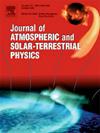Ionospheric TEC prediction in low-latitude Indian region during geomagnetic storm periods based on XGBoost with optuna framework and comparison with IRI-Plas 2020
IF 1.9
4区 地球科学
Q3 GEOCHEMISTRY & GEOPHYSICS
Journal of Atmospheric and Solar-Terrestrial Physics
Pub Date : 2025-08-14
DOI:10.1016/j.jastp.2025.106606
引用次数: 0
Abstract
This paper introduces a strong 24-h TEC forecast model based on the Extreme Gradient Boosting (XGBoost) algorithm, implemented for GPS-based TEC data at both the IISC and Chum stations. For a better tuning of the model's performance, two hyperparameter tuning approaches—Optuna and Hyperopt—were utilized. The assessment pertains to five primary GS events: the Halloween Storm (2003), St. Patrick's Day Storm (2015), the February 2022 Mother's Day Storm (2024), and yet another GS in 2024. The AI model forecasts were compared against the IRI-PLAS 2020 empirical model on the basis of standard performance measures such as Root Mean Square Error (RMSE), Mean Absolute Percentage Error (MAPE), and Mean Squared Logarithmic Error (MSLE). Results show that the Optuna-tuned XGBoost model always performed better than the IRI-PLAS 2020 model for all GS events. RMSE values for Optuna were considerably lower: 4.7254 for the Halloween Storm versus 8.7335 using IRI-PLAS, 2.8389 versus 17.4692 for St. Patrick's Day, 4.4167 versus 9.9611 for the 2022 storm, 10.8861 versus 16.4781 for the Mother's Day event, and 12.8778 versus 29.8309 for the second 2024 storm. For comparison, the XGBoost model optimized using Hyperopt, tested over the same events, had RMSEs of 14.52, 7.01, 5.19, 6.80 and 14.97, respectively. While Hyperopt outperformed the IRI-PLAS model in each scenario, Optuna produced the best results overall. These results confirm the effectiveness of machine learning, specifically the XGBoost model optimized using Optuna tuning, in observing intricate TEC dynamics during geomagnetic disturbances. The research points out how AI-driven forecasting can dramatically enhance space weather resilience by limiting error in prediction and providing more trustworthy GNSS and communication system functionality under high-impact solar activity.
基于XGBoost和optuna框架的低纬印度地区地磁风暴期间电离层TEC预测及与iris - plas 2020的比较
本文介绍了一种基于极端梯度增强(XGBoost)算法的强24小时TEC预测模型,该模型用于IISC和Chum站基于gps的TEC数据。为了更好地调整模型的性能,使用了两种超参数调整方法- optuna和hyperopt。该评估涉及五个主要的GS事件:万圣节风暴(2003年)、圣帕特里克节风暴(2015年)、2022年2月母亲节风暴(2024年)和2024年的另一个GS事件。基于标准性能指标,如均方根误差(RMSE)、平均绝对百分比误差(MAPE)和均方对数误差(MSLE),将AI模型预测与IRI-PLAS 2020经验模型进行比较。结果表明,在所有GS事件中,经过optuna调谐的XGBoost模型始终优于IRI-PLAS 2020模型。Optuna的RMSE值相当低:使用IRI-PLAS计算万圣节风暴的RMSE值为4.7254比8.7335,圣帕特里克节的RMSE值为2.8389比17.4692,2022年风暴的RMSE值为4.4167比9.9611,母亲节事件的RMSE值为10.8861比16.4781,2024年第二次风暴的RMSE值为12.8778比29.8309。相比之下,使用Hyperopt优化的XGBoost模型,在相同的事件上进行测试,rmse分别为14.52、7.01、5.19、6.80和14.97。虽然Hyperopt在每种情况下都优于IRI-PLAS模型,但Optuna的总体效果最好。这些结果证实了机器学习的有效性,特别是使用Optuna调谐优化的XGBoost模型,在地磁扰动期间观察复杂的TEC动态。该研究指出,人工智能驱动的预测如何通过限制预测误差,并在高影响太阳活动下提供更可靠的GNSS和通信系统功能,从而大大提高空间天气恢复能力。
本文章由计算机程序翻译,如有差异,请以英文原文为准。
求助全文
约1分钟内获得全文
求助全文
来源期刊

Journal of Atmospheric and Solar-Terrestrial Physics
地学-地球化学与地球物理
CiteScore
4.10
自引率
5.30%
发文量
95
审稿时长
6 months
期刊介绍:
The Journal of Atmospheric and Solar-Terrestrial Physics (JASTP) is an international journal concerned with the inter-disciplinary science of the Earth''s atmospheric and space environment, especially the highly varied and highly variable physical phenomena that occur in this natural laboratory and the processes that couple them.
The journal covers the physical processes operating in the troposphere, stratosphere, mesosphere, thermosphere, ionosphere, magnetosphere, the Sun, interplanetary medium, and heliosphere. Phenomena occurring in other "spheres", solar influences on climate, and supporting laboratory measurements are also considered. The journal deals especially with the coupling between the different regions.
Solar flares, coronal mass ejections, and other energetic events on the Sun create interesting and important perturbations in the near-Earth space environment. The physics of such "space weather" is central to the Journal of Atmospheric and Solar-Terrestrial Physics and the journal welcomes papers that lead in the direction of a predictive understanding of the coupled system. Regarding the upper atmosphere, the subjects of aeronomy, geomagnetism and geoelectricity, auroral phenomena, radio wave propagation, and plasma instabilities, are examples within the broad field of solar-terrestrial physics which emphasise the energy exchange between the solar wind, the magnetospheric and ionospheric plasmas, and the neutral gas. In the lower atmosphere, topics covered range from mesoscale to global scale dynamics, to atmospheric electricity, lightning and its effects, and to anthropogenic changes.
 求助内容:
求助内容: 应助结果提醒方式:
应助结果提醒方式:


